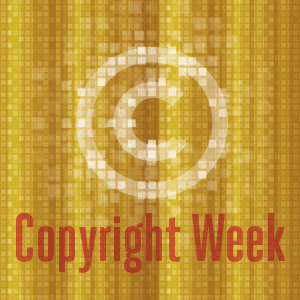 We’re taking part in Copyright Week, a series of actions and discussions supporting key principles that should guide copyright policy. Every day this week, various groups are taking on different elements of the law, and addressing what’s at stake, and what we need to do to make sure that copyright promotes creativity and innovation.
We’re taking part in Copyright Week, a series of actions and discussions supporting key principles that should guide copyright policy. Every day this week, various groups are taking on different elements of the law, and addressing what’s at stake, and what we need to do to make sure that copyright promotes creativity and innovation.
The encroachment of long copyright term on the public domain has appeared frequently in the news in recent days. As I discussed here, copyright has cast a long shadow over contemporary understandings of the Holocaust by restricting the use of two World War II-era books on opposite ends of the moral spectrum: The Diary of Anne Frank and Hitler’s Mein Kampf. The Swiss foundation that owns the copyright in The Diary of Anne Frank appears to be using copyright arguments to prevent the Anne Frank Museum in the Netherlands from posting an annotated version of the Diary online. Likewise, until the German copyright expired at the end of 2015, the Bavarian government had used its ownership of the copyright in Mein Kampf to prevent the publication of even academic editions of Hitler’s manifesto.
The celebration of Martin Luther King Jr. Day this past Monday also brings to mind how copyright term forced filmmaker Ava DuVernay to paraphrase MLK’s speeches in the film Selma. As I discussed here, the King estate would not license the speeches he delivered in 1965 to DuVernay, requiring her to rewrite history to avoid copyright liability.
All these situations involve the application of copyright protection decades beyond the death of the author; the standard term of protection in the United States and the European Union is the life of the author plus 70 years. But any application of copyright after the death of the author raises serious policy questions and creates anomalous situations.
Consider the copyright restrictions on the nature of tributes to David Bowie. In the past, when prominent performers died, radio stations would play entire albums in their memory. Now, however, a proposed “Bowie Day” wouldn’t be permissible because most radio stations simultaneously transmit their programs over the Internet, where more stringent copyright rules apply. (Under 17 U.S.C. § 114, a webcaster is allowed to play no more than four tracks by the same featured artist, or three tracks from the same album, within a three hour period.) Because it is economically infeasible for stations to have separate programming for Internet and terrestrial transmissions, the rules for Internet transmission govern a station’s programming choices for both its terrestrial and radio transmissions. Thus, most radio stations could not play entire Bowie albums, including his most popular albums from the late 1960s and early 1970s, even though were more than 40 years old.
Further, the Washington Post recently observed that “there is no better time to be an artist than when you’ve just died.” The Post noted that “as soon as death silences a popular entertainer…his popularity and financial worth soar.” Obviously the artist himself does not benefit from this spike in sales, and it cannot incentivize him to create more works. Additionally, the rationale used in the past to justify post-mortem copyright protection—encouraging investment in the distribution of the artist’s work—no longer applies given the low costs of Internet distribution.
Post-mortem copyright also is unnecessary to motivate the creation of derivative works based on the artist’s work. Any new expression receives its own copyright. Indeed, post-mortem copyright restricts the creation of derivative works by anyone unauthorized by the copyright owner.
Thus, post-mortem copyright benefits only the author’s heirs. To be sure, there is an equity argument for an author receiving a revenue stream from his work (or otherwise controlling its use) throughout his lifetime, even if the duration of the stream is longer than the maximum term under the Copyright Act of 1790 (28 years) or the Copyright Act of 1909 (56 years). But what is the argument in favor of the author’s heirs continuing to receive that revenue stream for another 70 years? How does that further the objectives of the copyright law to, in Judge Leval’s words, “expand public learning while protecting the incentives of authors to create for the public good?”
Of course, given that the Berne Convention mandates a term of protection of life plus 50 years, and various free trade agreements (including the Trans Pacific Partnership Agreement) specify a term of life plus 70, there is no chance of the United States shortening the copyright term to the life of the author.
While it would not address the “Bowie Day” problem (which results from an express prohibition in the statute), an argument certainly can be made that courts should apply limitations and exceptions like fair use more vigorously in the post-mortem term of the copyright. The Supreme Court in the Betamax case recognized that the IP laws must achieve “a difficult balance between the interests of authors and inventors in the control and exploitation of their writings and discoveries on the one hand, and society’s competing interest in the free flow of ideas, information, and commerce on the other.” Courts might conclude that the public interest balances more strongly against the interests of an estate, at least when compared to the interests of the living author.
The post Cha-cha-changes to the Application of Copyright Term appeared first on Disruptive Competition Project.
